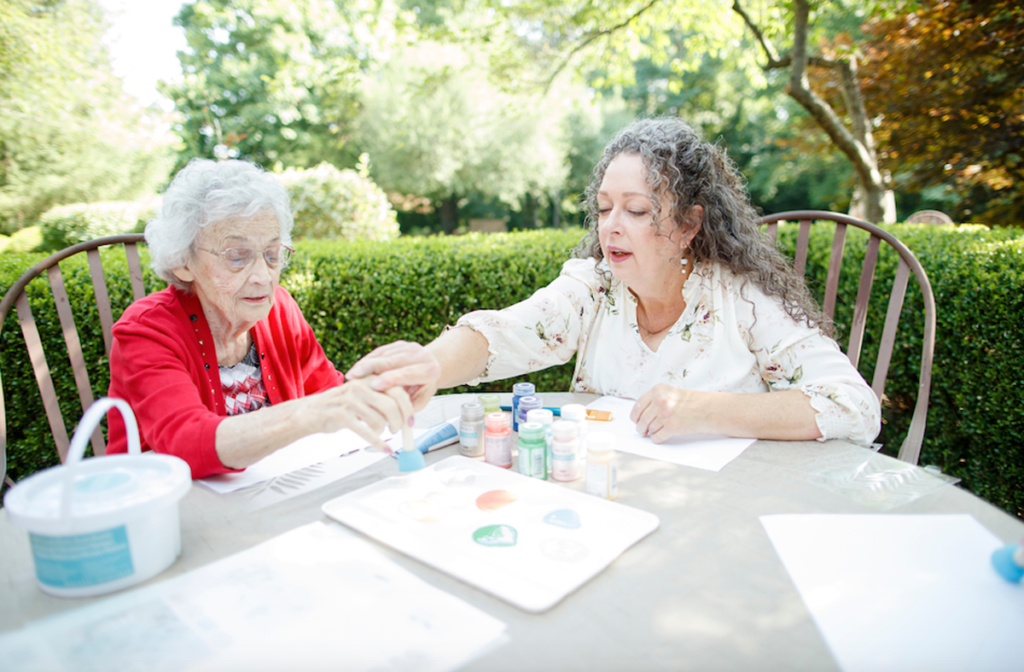Assisted Living vs Memory Care: Comparing The Differences
Assisted living, memory care facilities, nursing homes—when it comes to finding a place and home that will provide excellent care for your loved one, the terms alone can be confusing.
Which one does your mother or father need? What is the difference between them?
For the sake of this article, we will be breaking down the difference between memory care facilities and assisted living facilities. To learn about the difference between memory care facilities and nursing homes, read our article Memory Care vs. Nursing Homes: Comparing The Differences.
Assisted Living Facilities
Assisted living facilities are full-time residences created for senior adults who need assistance with activities of daily living (ADLs). These activities include walking, bathing, dressing, using the bathroom, getting in and out of bed, and eating.
Adults suited for assisted living don’t need 24-hour care or supervision. They are still independent in some areas of life but need assistance doing certain things.
There are approximately 30,200 assisted living facilities in operation in the U.S. today. The average number of residents in each facility is about 33. One hundred residents or more is considered a very large facility.
Each facility varies as far as what they offer residents, what their facilities look like, and what kind of staff they have. But most assisted living facilities offer the following:
- Daily activities such as book clubs, music, entertainment, and exercise classes
- At least three meals a day served in a communal area
- Laundry and cleaning service for each room
- 24-hour staff available to assist residents
- Safety and building security
- Transportation services
- Outdoor garden space or courtyard
Assisted living facilities employ a nursing staff equipped to assist in all areas of ADLs. These include licensed vocational nurses, clinical nurses, and personal care technicians.
Medicare and Medicaid do not cover the cost of assisted living facilities like they would a nursing home. The median cost per room in a facility in the U.S. runs about $4,300 per month and will vary depending on location.
Memory Care Facilities
Memory care facilities offer everything an assisted living facility would but with a higher level of 24-hour care. Residents of memory care facilities typically have Alzheimer’s disease, senior dementia, or another form of memory loss. Because of this, memory care facilities have highly skilled and trained staff equipped to offer care to residents with specific memory loss issues. They are also designed to promote the health and safety of a senior with Alzheimer’s or dementia.
At Barton House, everyone on staff is a caregiver.
Our philosophy at Barton House Memory Care is that everyone on staff is a caregiver. Trained nurses, administration, kitchen staff—everyone is trained on how to care for our residents.
Alzheimer’s and dementia can cause many people to suffer from disorientation. Therefore, memory care residents are much more prone to wander than assisted living residents. Because of this, memory care facilities should be designed in a unique pattern and flow catered to the residents.
At Barton House, we have extra security to make sure residents don’t get lost or leave the facility without someone accompanying them.
At Barton House Memory Care of Sugar Land, Texas, we have extra security in place to make sure residents don’t get lost or leave the facility without someone accompanying them. Because we don’t want our residents to feel trapped, we’ve designed our facilities in a circular pattern. Residents can safely move in and out of the building, from their room to the garden to the kitchen to the living room without getting lost or putting themselves at risk.
At Barton House, each room is designed with a different door pattern and a memory box hanging on the wall with photos and memorabilia so each resident can recognize which room is theirs without getting confused.
We’ve also designed each room with a different door pattern and a memory box hanging on the wall with photos and memorabilia so each resident can recognize which room is theirs without getting confused.
At Barton House, we never have more than 24 residents at a time.
The number of residents in memory care facilities is typically lower than the number of residents in an assisted living facility. This is to allow a higher staff-to-resident ratio. At Barton House Memory Care of Sugar Land, we never have more than 24 residents at a time. This allows residents to have more one-on-one care and to get to know each other as a community.
At Barton House, we offer five meals a day so our residents get the proper nutrition and hydration they need.
Memory care facilities should also emphasize nutrition and hydration. Forgetting to eat and drink is typical and exacerbates memory loss symptoms. At Barton House, we offer five meals a day so our residents get the proper nutrition and hydration they need.
At Barton House, art, music, gardening, and exercise classes are popular with our residents because of how they promote social activity as well as mental and physical health.
Like assisted living facilities, memory care facilities offer programs and activities for residents every day, but these activities will be more focused on the process and maintaining skills. Art, music, gardening, and exercise classes are popular with our residents because of how they promote social activity as well as mental and physical health.
Barton House provides specialized care improving your family member’s quality of life and slowing the progression of memory loss.
Because of the higher level of care offered at memory care facilities with highly trained staff, uniquely designed buildings, and higher security, the cost is higher than that of assisted living. The median price per room at a memory care facility is about $5,250 per month.
Assisted living facilities and memory care facilities both offer excellent care for senior residents. What matters is the level of care your loved one needs. If your loved one is living with memory loss, Alzheimer’s disease, or dementia, a memory care facility can offer much more specialized care than assisted living, improving your family member’s quality of life and slowing the progression of memory loss.
3 Differences Between Assisted Living and Memory Care

At face value, memory care and assisted living appears to have many similarities. However, when you look into their specializations and functions you will see several differences between these two types of senior living communities.
1. Distinct types of staff training
Because of the nature of a memory care community, its staff gets specialized training in caring for people with dementia. For example, at Barton House, we train our staff members in the best practices for dementia care. Memory care staff also go through further instruction to be well-versed on disease-related behaviors, communication techniques and focus on residents’ strengths rather than weaknesses.
Like a memory care facility, assisted living has caregivers trained with knowledge of senior care. However, they seldom have the expertise needed to care for people with dementia, especially Alzheimer’s disease.
2. Each provides it own specially designed activities
In an assisted living community, residents participate in various entertainment activities, such as dessert socials or birthday parties.
On the other hand, memory care encourages residents to participate in music therapy and specific physical exercises like gardening that aid people with dementia. Hence, they stay engaged, social, and a genuine part of the community.
3. Surroundings and housing setup
Because of the nature of dementia, safety is a significant concern in memory care communities.
Typically, memory care facilities have functionally designed spaces that provide extra safety for people with dementia. For example, Barton House has color-coded walls, simple layouts, and defined areas. This allows residents to easily move around without getting lost or hurt.
While assisted living communities offer basic security measures like in-room emergency alert systems, they do not provide these extra safety precautions necessary for residents with dementia. This can make it unsafe for elderly parents living with memory conditions.
Assisted Living vs Memory Care Costs

When selecting a specialized memory care facility or a general assisted living facility for your parent, the cost may come into play. So, how does memory care compare to assisted living in terms of pricing?
Following are a few things you should know.
How much does Assisted Living Cost?
The median cost for an assisted living facility is about $4,300 a month and may vary based on location and the types of services they provide. In many instances, a facility in a large city costs more than one in a smaller town or rural area.
Generally, assisted living communities charge a base monthly fee covering three meals for residents, transportation to and from medical checkups, housekeeping, physical activities, and live-in room and board.
How much does Memory Care cost?
Since memory care facilities offer specialized care and enhanced services, they cost more than general assisted living communities.
Most memory care facilities charge between $4,000 to $8,000 a month, with the median cost about $5,250, and varies based on location. In spite of a higher cost, the value of services and care far exceed that of assisted living facilities.
What Services Can I Expect with Assisted Living vs Memory Care?

As previously mentioned, memory care specializes in caring for people with dementia, while assisted living provides day-to-day support for the elderly who can go about their activities independently.
Services Covered by Assisted Living
An assisted living facility will provide support for your loved one across the following areas:
- Minor over site with some ADLs (Activities of Daily Living)
- Meal services
- Medication management
- Care coordination
- Housekeeping and laundry services
- Exercise classes
- Transportation to appointments
Services Covered by Memory Care
Memory care provides similar services as assisted living facilities, with the addition of specialized focus for someone with memory loss and disease-related behaviors.
These services include:
- Assisting with all ADLs
- Meal service and assistance as needed
- Medication management and oversite
- Care coordination and follow up
- Housekeeping and laundry services
- Exercise classes
- 24-hour care and supervision
- Secured entrances and exits to prevent wandering
- Memory-enhanced therapies
- High staff-to-resident ratio
- Unique layouts to reduce confusion
- Activities specifically focused for dementia
How to Choose Between Assisted Living vs Memory Care

Choosing between assisted living and memory care isn’t a decision you should make lightly or quickly. Ultimately, there are several things you need to consider before opting for a general assisted living facility over specialized memory care and vice versa.
For instance, if your loved one shows signs of cognitive decline, you should consider finding a home for them in a memory care community. On the other hand, assisted living may be best if memory loss is not an immediate concern.
Cognitive decline behaviors you should look out for in your elderly parents or loved one include:
- When your loved one starts getting lost in familiar places
- When your loved one requires assistance and lots of directions for their daily tasks
- When your loved one requires mobility assistance
- Withdrawal from interactions or socializing
- When your loved one needs assistance with medications
- When your loved one 24-hour supervision
Another consideration is the level of independence and socialization that your family member displays. If your parents are pretty much independent, then assisted living is an excellent choice. However, memory care is a more specialized option for people with immediate memory loss concerns who aren’t capable of independent living independently.
FAQs: Assisted Living vs Memory Care
Assisted Living vs Memory Care: A Simple Comparison Chart
Assisted Living
Memory Care
Cost
Cost
The monthly median cost for one room at an assisted living facility is $4,300. However, depending on your location, you can pay between $3,000 and $6,500 per month.
The average cost of memory care is $5,250 per month. However, depending on your location, you can pay between $4,000 and $8,000 each month. Though this is higher than Assisted Living it is not an apples-to-apples comparison. The benefits received with a memory care facility far outweigh those for an assisted living facility.
Cost
Activities
Activities offered at assisted living facilities vary but most include activities offered by memory care facilities as well as book clubs and other activities in which higher functioning seniors can participate.
The activities in a memory care facility are directed toward helping the person improve their quality of life. At Barton House, we encourage socials, music, art, and exercise to help the residents maintain a routine.
Cost
Staff Training
Staff at assisted living facilities are trained in assisting residents with ADLs. Some staff members can offer more specialized medical care.
The staff in a memory care facility undergo additional training to know how to care for simple to complex challenges faced by people living with memory loss.
Cost
Who is it for?
Assisted living is for older adults who are independent but need help with ADLs such as walking, eating, and bathing.
Memory care facilities provide care for people with dementia and Alzheimer’s, typically at the middle and later stages of these conditions.
Cost
Level of Care
Care at assisted living facilities is largely centered around assisting with ADLs, cleaning and housekeeping, and meal preparation for residents.
Care is provided for people in every stage of dementia or Alzheimer’s, including assistance with ADLs, medication management, and effective therapies with music.
Freedom of Movement
Because residents at assisted living facilities are not as prone to wander and endanger themselves, doors and exits may not remain locked at all times, and residents are free to walk around the facilities indoors and outdoors.
Because of their condition, most dementia patients cannot move around a facility without a staff’s oversight. The doors and exits are kept shut to stop patients from wandering off.
Barton House; however, is designed to enable residents to have more movement, but in a secure environment.
Average Number of Residents
The average number of residents in an assisted living facility is 33, but facilities can have as many as 100+ residents.
A memory care community usually has fewer than 50 residents. At Barton House, we only have 24 residents at a time.
Summary
Both memory care and assisted living are viable care options for your loved one. However, for people with dementia, a memory care community is better positioned to give them the long-term care and support they need to improve and maintain their quality of life.
At Barton House, we created the look and feel of a real home to help your loved ones with dementia enjoy better lives.
Contact us today to learn more about our specialized memory care community. We’ve been caring for seniors since 1999.
Come see why Barton House is the best memory care facility in Sugar Land.





